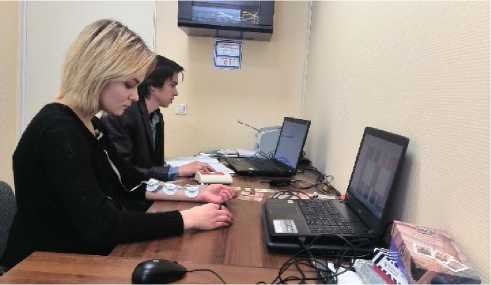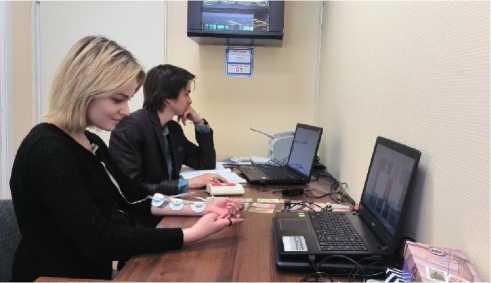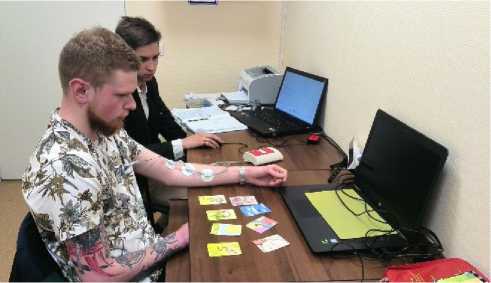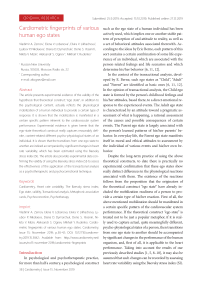Cardiometric fingerprints of various human ego states
Автор: Zernov Vladimir A., Lobanova Elena V., Likhacheva Elvira V., Nikolaeva Lyubov P., Dymarchuk Diana D., Yesenin Denis S., Mizin Nikita V., Ognev Aleksandr S., Rudenko Mikhail Y.
Журнал: Cardiometry @cardiometry
Рубрика: Original research
Статья в выпуске: 15, 2019 года.
Бесплатный доступ
The article presents experimental evidence of the validity of the hypothesis that theoretical construct “ego state”, in addition to the psychological content, actually reflects the physiological mobilization of a human individual to provide a certain type of response. It is shown that the mobilization is manifested in a certain specific pattern inherent to the cardiovascular system performance. Experimental evidence is given herein that the ego-state theoretical construct really captures reasonably definite, content-related different psycho-physiological states of an individual. It is shown that the transitions from one ego state to another are indeed accompanied by significant changes in heart rate variability, which has been estimated using the Baevsky stress index (SI). The article also provides experimental data confirming the validity of using the Baevsky stress index (SI) to assess the effectiveness of the application of the transactional analysis as a psychotherapeutic and psychocorrectional technique.
Cardiometry, heart rate variability, baevsky stress index, ego state, transactional analysis, metaphoric associative cards, psychocorrection, psychotherapy
Короткий адрес: https://sciup.org/148311453
IDR: 148311453 | DOI: 10.12710/cardiometry.2019.15.3842
Текст научной статьи Cardiometric fingerprints of various human ego states
Vladimir A. Zernov, Elena V. Lobanova, Elvira V. Likhacheva, Lyubov P. Nikolaeva, Diana D. Dymarchuk, Denis S. Yesenin, Nikita V. Mizin, Aleksandr S. Ognev, Mikhail Y. Rudenko. Cardiometric fingerprints of various human ego states. Cardiometry; Issue 15; November 2019; p.38-42; DOI: 10.12710/cardiome-try.2019.15.3842; Available from: issues/no15-november-2019/cardiometric-fingerprints
In psychological and psychotherapeutic practice, for more than half a century, a psychological construct 38 | Cardiometry | Issue 15. November 2019
such as the ego state of a human individual has been actively used, which implies one or another stable pattern of perception of and attitude to reality, as well as a set of behavioral attitudes associated therewith. According to the ideas by Eric Berne, each pattern of this sort contains a certain combination of some life experience of an individual, which are associated with the person-related feelings and life scenarios and which determine his/her behavior [6, 11, 12].
In the context of the transactional analysis, developed by E. Berne, such ego states as “Child”, “Adult” and “Parent” are identified as basic ones [6, 11, 12]. In the opinion of transactional analysts, the Child ego state is formed by the person’s childhood feelings and his/her attitudes, based there, to a direct emotional response to the experienced events. The Adult ego state is characterized by an attitude toward a pragmatic assessment of what is happening, a rational assessment of the causes and possible consequences of certain events. The Parent ego state is largely associated with the person’s learned patterns of his/her parents’ behavior. In everyday life, the Parent ego state manifests itself in moral and ethical attitudes to assessment by the individual of various events and his/her own behavior.
Despite the long-term practice of using the above theoretical constructs, to date there is practically no experimental confirmation that these ego states show really distinct differences in the physiological reactions associated with them. The existence of the reactions follows from the proposition that the originators of the theoretical construct “ego state” have already included the mobilization readiness of a person to provide a certain type of his/her reaction. First of all, the above mentioned mobilization should be manifested in a certain specific pattern of the cardiovascular system performance. If the theoretical construct “ego state” is treated not to be just a popular metaphor, if it is really used to capture actual, quite meaningfully different, psycho-physiological states of a person, then transitions from one ego state to another should be accompanied by significant changes in the performance of the human organism, and, first of all, it is applicable to the heart performance. Taking into account the results of our previously described studies [1, 5, 8–10], it may also be assumed that such changes can be recorded by assessing heart rate variability using the Baevsky stress index (SI).
Materials and Methods
To test the hypothesis set up above, we have carried out a series of experiments, where the key ego states in the context of the transactional analysis have been modeled using metaphoric associative cards, and the psycho-physiological reactions, corresponding to these states, have been recorded with our PC-assisted hemodynamic analyzer Cardiocode. Following this way, we have taken into account the data of our previous experiments, which confirm that the increased, in comparison with average values, Baevsky stress index (SI) can be considered as a sign of the sthenic response to a stimulus, and the reduced SI value can be treated as a sign of the asthenic response to a stimulus [8, 9]. We have also taken into consideration that it is precisely these SI values that are more effective indicators in the evaluation of the person’s emotional reactions nature than mere changes in his/her heart rate only [1, 5].
Taking into account the clearly identified by the end of the last century, ever increasing, tendency, called “the Pictorial Turn” [6, 8, 9], we have employed metaphoric associative cards as stimulation materials to actualize the ego states described above herein. As shown in numerous scientific publications, the images used in the metaphoric cards supports the therapist to actualize certain psycho-physiological conditions of the patient, which can be used as a kind of “targets” for therapeutic control [2-4, 6, 8, 9].
The Moritz Egetmeyer standard metaphoric associative cards (OH-Cards) and the sets of coaching associative cards created by I. Shmelev and S. Gracheva have been used in our experiments. This choice has been made taking into account the widespread longterm practice of the efficient use of precisely these sets of metaphoric associative cards by consultants and psychotherapists of various profiles [2-4].
We have included in our study 145 respondents (the average age was 20.5 years; the standard deviation was 5.68 years in the sample as a whole). A single algorithm for the work by all respondents has implied the sequential execution of the following tasks: Initially, respondents are asked to select those metaphoric cards that they associate with such ego states as negative Adult, Parent and Child, as well as positive Adult, Parent and Child.
Then, each respondent for 15 seconds alternately has fixed his/her attention on the cards that he/she associated with each of the above ego states. The final task for each respondent is to select all the metaphoric



cards that he/she associates with positive ego states and to fix his/her attention on all such cards for 15 seconds at the same time.
When performing the above tasks, the cardiograms of the examinees were recorded using the Cardiocode PC-aided hemodynamic analyzer. The corresponding recording procedures at this stage of the studies are shown in the pictures below herein.
Upon completion of the above testing procedures, using the algorithms in the analyzer software, the Baevsky stress index (SI) has been automatically calculated for each examinee.
The statistical analysis of the obtained data has been performed using statistical package STADIA 8.0.
Results and Discussion
The obtained statistical patterns in determining the SI values for various ego-states in the respondents are presented in Table 1 herein.
Table 1
The main statistical parameters of the SI values for various ego-states of respondents
|
Egostate |
Arithmetic mean |
Standard deviation |
Median |
Asymmetry |
Excess |
|
1 |
409.1 |
442 |
287 |
4.401 |
30.82 |
|
2 |
277.3 |
255.2 |
206 |
2.895 |
13.12 |
|
3 |
363.5 |
328.7 |
280 |
2.871 |
13.97 |
|
4 |
272.6 |
307.4 |
202 |
5.154 |
39.98 |
|
5 |
372.9 |
415 |
250 |
5.133 |
40.88 |
|
6 |
289.6 |
282.4 |
223 |
4.899 |
38.09 |
|
7 |
228.3 |
208.4 |
156 |
2.502 |
10.65 |
The first column in the given table and all the following tables shows the numbers that indicate the following ego-states: 1, 3, 5 – successively induced negative states Adult, Parent and Child; 2, 4, 6 - successively induced positive states Adult, Parent and Child; 7 – an integrative ego-state, caused by the respondent's simultaneous concentration on the stimuli, with which he/she has designated as the positive states Adult, Parent and Child.
The static significance of differences in mean values is confirmed using the χ criterion (chi-square), which, as noted above, has been estimated with statistical software complex STADIA 8.0.
The obtained distributions are other than those defined by Gauss-Laplace. Therefore, in order to identify correlation relationships, we have used Spearman and Kendall coefficients. Since the nature of the identified relationships for each of these coefficients and the factor structure revealed for each of them are similar, we give only data for the Spearman coefficient below herein because of the more accurate generalization of the latter.
The tables below show the results of various variants for optimizing the factor structure of the data using Spearman correlation coefficients. Table 2 shows the parameters of the factor structure after using the orthogonal rotation method (Varimax Rotation), with which we have applied to minimize the number of variables with “high loadings” on each factor. Table 3 presents the data obtained after applying the quartimax rotation, where we intend to minimize the number of factors that are required for a meaningful interpretation of each of the variables used. Table 4 shows the results of the equimax rotation application, 40 | Cardiometry | Issue 15. November 2019
The factor structure of the correlation relationships after employing the varimax rotation method
|
Ego-state |
Factor Numbers |
|||
|
1 |
2 |
3 |
4 |
|
|
1 |
-0.2871 |
0.7978 |
-0.3243 |
|
|
2 |
0.4717 |
0.7415 |
||
|
3 |
-0.9168 |
-0.2296 |
||
|
4 |
0.4312 |
-0.3647 |
-0.6729 |
|
|
5 |
0.3335 |
-0.848 |
||
|
6 |
0.59 |
0.3345 |
-0.4826 |
|
|
7 |
0.8814 |
|||
Table 3
The factor structure of the correlation relationships after applying the quartimax rotation method
|
Ego-state |
Factor Numbers |
|||
|
1 |
2 |
3 |
4 |
|
|
1 |
-0.2582 |
0.7982 |
-0.3446 |
|
|
2 |
0.4806 |
0.7345 |
||
|
3 |
-0.8996 |
-0.272 |
||
|
4 |
0.4327 |
-0.3269 |
-0.692 |
|
|
5 |
0.3256 |
-0.8583 |
||
|
6 |
0.5914 |
0.323 |
-0.4932 |
|
|
7 |
0.8848 |
|||
Table 4
The factor structure of the correlation relationships with the use of the equimax rotation method
As can be seen from the data presented herein above, the SI values for the positive ego-states are components of some factors, and the SI values for the negative ego-states are found as components of the other factors. Moreover, this regularity and this factor structure, as a whole, are retained with all the rotation variants used. This, similar to the fact of statistically significant differences in average SI values, also demonstrates the substantive commonality of the positive ego-states, which significantly differs from the substantive commonality of the SI data for the negative ego-states.
It is noteworthy that the most powerful factors in all variants of the rotation methods included are both the SI values for all positive ego-states, when they are actualized individually, and the SI value, which has been obtained, when respondents have worked with all three positive ego-states. In this regard, it should be mentioned that in the transactional analysis the successful completion of therapy is considered to be the achievement by the patient of the level of organization of his/her life, when his/her Child is able to freely realize his authentic intentions with the help of the effectively functioning Adult under protection of the adequate Parent [7, 13, 14]. In other words, the factor structure confirms the presence of a positive integrative effect due to the joint actualization of the positive varieties of the imaginary Adult, Parent and Child in the respondents at their psycho-physiological level, since it is precisely that type of tasks that corresponds to the optimal Baevsky stress index.
When testing the hypothesis on the difference in psycho-physiological markers associated with certain ego-states of a person, attention should be drawn to the commonality and specificity of the data obtained in all the described types of transformations in the revealed correlation relationships (see table 5 herein).
As we can see in the last table herein, the indicators of commonality and specificity of the SI values for the positive and the negative ego-states have noticeable differences. It has been found that the SI values for the negative ego-states have the highest commonality (i.e. they have the largest share of dispersion in relation to the identified factors that are the most universal). At the same time, the SI values for the positive ego-states
Commonality and specificity between the SI values in various ego-states
Conclusions
The experimental evidence of the validity of the hypothesis, that theoretical construct “ego state”, in addition to the psychological content, actually reflects the physiological mobilization of a human individual to a certain type of response, has been obtained in the given study. In particular, such mobilization is manifested in a certain fingerprint of the cardiovascular system performance.
The recorded experimental data demonstrate that the theoretical construct “ego-state” is not just a successful metaphor, but that with the use thereof we can really capture completely definite and meaningfully different psycho-physiological states of a person. The transitions from one ego-state to another are indeed accompanied by significant changes in our organism, and, first of all, in our heart performance. The reliable fingerprint of such changes is the heart rate variability assessment with the utilization of the Baevsky stress index (SI).
Besides, as in [12], we have produced experimental confirmation of the validity of usability of such a complex cardiometric indicator as the Baevsky stress index (SI) in order to assess the effectiveness of various psycho-correction techniques. But it should be mentioned that while it has been applicable to the methods of psychosomatic self-regulation [12], now the efficient, reasonable, use of the Baevsky stress index is also shown in relation to the transactional analysis.
Statement on ethical issues
Research involving people and/or animals is in full compliance with current national and international ethical standards.
Conflict of interest
None declared.
Author contributions
The authors read the ICMJE criteria for authorship and approved the final manuscript.
Список литературы Cardiometric fingerprints of various human ego states
- Abdurakhmanov RA, Agapov VS, NN Azarnov, et al. Modeling and optimization in human behavior. Moscow, 2019.
- Buravtsova NV. Associative cards in psychotherapy of destructive fingerprints. Novosibirsk, 2018.
- Buravtsova NV. The use of associative cards in work¬ing with children and teenagers. Novosibirsk, 2017.
- Dmitrieva NV, Buravtsova NV. Metaphorical cards in counseling and therapy. Novosibirsk, 2015.
- Zernov VA, Kozintsev PA, Likhachev EV, et al. Ap¬plication of PC-aided device Cardiocode in engineer¬ing and social psychology. Higher education today. 2019. No. 3. P. 68-75.
- Alexander J. Iconic Experience in Art and Life // Theory, Culture & Society. 2008. Vol. 25 (5).
- Berne E. BEYND GAMES AND SCRIPTS. N.Y.: Ballantine Books, 1981.
- Dors B, Vogel R. Aktive Imagination. – Stuttgart, 2014.
- Mitchell W.J.T. The Pictorial Turn. Mitchell W. J. T. Picture Theory. Essays on Verbal and Visual Repre¬sentation. Chicago; London: The University of Chica¬go Press, 1994.
- Ognev AS, Zernov VА, Likhacheva EV, et al. Car¬diometric detection of effects and patterns of emo¬tional responses by a human individual to verbal, au¬dial and visual stimuli. Cardiometry. 2019;14:79-86.
- Ognev AS, Zernov VA, Likhacheva EV, et al. Use of cardiometry and oculography in concealed informa¬tion detection. Cardiometry. 2019;14:87-95.
- Ognev AS, Zernov VА, Likhacheva EV, et al.
- Validity of cardiometric performance data: an integral part of complex assessment of training session effec¬tiveness. Cardiometry. 2019;14:96-100.
- Rudestam K. Experiental Groups in Theory and Practice. Monterey, Calif.: Thomson Brooks/Cole, 1997.
- Stewart I, Joines V. TA Today. A New Introduction to Transactional Analysis. Calif.: Lifespace Pub., 2012.


